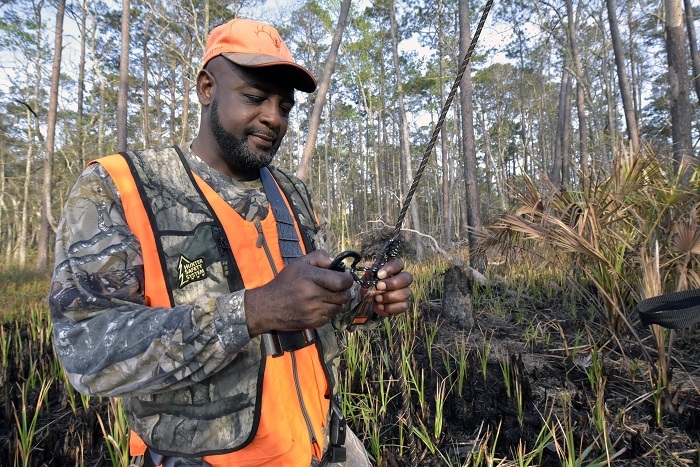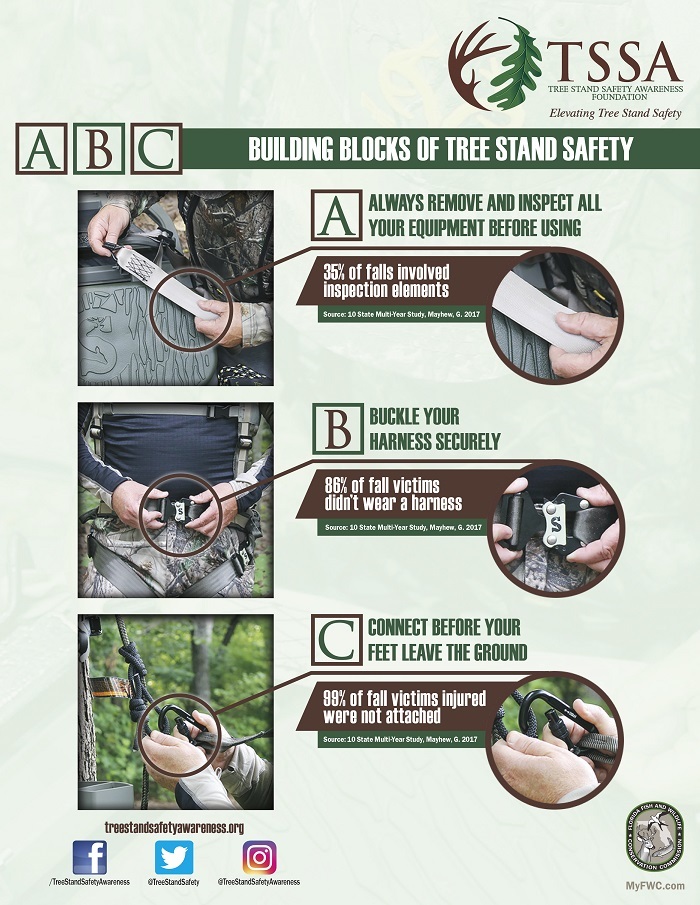Test your knowledge about treestand safety
Florida Fish & Wildlife Conservation Commission sent this bulletin at 10/01/2020 10:40 AM EDT
(Having trouble viewing this email? View it as a Web page.)
Oct. 1, 2020
Suggested Tweet: Deer hunters: How much do you know about treestand safety? Take the quiz and find out! https://content.govdelivery.com/accounts/FLFFWCC/bulletins/2a3a9d2 #Florida @MyFWC
Suggested photo caption: Every time you hunt from a treestand, you should wear a full-body safety harness; use a rope safety line with a prusik knot to stay connected to the tree from the time you leave the ground until you return; and pull ALL equipment – including your unloaded firearm – into your stand using a haul line.

Test your knowledge about treestand safety
This season, many deer hunters will be hunting from ladder, climbing or hang-on treestands to keep their scent above the ground, give themselves a better line of sight and remain undetected. You can stay safe when hunting from an elevated platform by following a few simple precautions. Take the quiz below to find out how much you know about treestand safety.
1) What safety equipment should you have to hunt from a treestand?
a) Full-body safety harness.
b) Rope safety line.
c) Haul line for your gun/bow.
d) All of the above.
The correct answer is d) all of the above. Every time you hunt from a treestand, you should wear your full-body safety harness; use a rope safety line with a prusik knot to stay connected from the time you leave the ground to when you return to terra firma; and pull ALL equipment – including your unloaded firearm – into your stand using a haul line.
2) True or false: When hunting from a ladder stand, hunters should use a rope safety line to climb up and down.
True. Ladder stands are perceived as safer than other types of stands, however, it’s critical to your safety that you follow all safety guidelines when using them, including using a full-body safety harness and a rope safety line with prusik knot to stay connected to the tree while climbing up and down the ladder.
3) What is the No. 1 reason falls occur?
a) Treestand not assembled correctly.
b) Slip/loss of grip.
c) Bad weather.
d) Broken straps.
The correct answer is b) Slip/loss of grip. The No. 1 reason falls occur is people lose their grip and slip while climbing up and/or down. That’s why it’s always important to wear nonslip boots, and clean mud and other debris off your boots before climbing. In addition, always keep three points of contact with the ladder while climbing up or down. Both hands and a foot or both of your feet and one hand should be used to support your body weight when using a ladder. Also, using a haul line to pull your gear up will keep your hands free for climbing.
4) True or false: It’s not necessary to check stands before the start of every hunting season.
False. The No. 2 reason falls occur is due to straps breaking. Check your treestands, especially ladder stand straps and chains, every season and before each use for signs of wear, fatigue, and cracks, and for loose or missing nuts and bolts. Replace straps, chains, and nuts and bolts as needed with manufacturer-approved replacement parts.
5) In what type of treestand is an incident most likely to occur?
a) Homemade stand.
b) Lock-on.
c) Climber.
d) Ladder.
The correct answer is b) Lock-on. National statistics kept by the Tree Stand Safety Awareness Foundation indicate lock-on stands account for most falls (31%). Climbers are second at 25%, and ladder stands (20%) and homemade stands (20%) are tied for third. The important thing to remember is falls can occur using any type of elevated platform, so it’s important to always follow safety guidelines.
6) True or false: Treestand falls are more likely to occur while bowhunting.
False. National statistics kept by the Tree Stand Safety Awareness Foundation indicate about 50% of falls occur while bowhunting and 50% occur by those hunting with a firearm. Be vigilant about treestand safety no matter what method of take you’re using.
7) Which of the safety steps is most important when hunting from a treestand?
a) Follow the manufacturers guidelines when assembling and using treestands.
b) Inspect all treestand and safety equipment before using it.
c) Practice using your treestand and associated safety equipment before your hunt.
d) All of the above.
The correct answer is d) All of the above. Following each of the above steps can help ensure you return home to your family at the end of the hunt.
8) True or false: When using a lock-on style treestand, you should step up to the seating platform.
False. When using lock-on stands, make sure the climbing aids or steps are installed above the stand so you are stepping down onto the seating platform. And, of course, make sure you’re using a full-body safety harness and rope safety line.
9) True or false: New hunters are more likely to fall while using a treestand.
False. Data shows experienced hunters account for most treestand incidents. The average age of victims who fall is late 40s. Whether it’s your first time to use a treestand or your 500th, always follow the ABCs of treestand safety: Always remove and inspect your equipment before using it; Buckle your safety harness; and Connect to the tree before your feet leave the ground.
10) What percentage of falls occur by someone not wearing a full-body safety harness?
a) 86%.
b) 53%.
c) 41%.
d) 25%.
The correct answer is a) 86%, according to national statistics kept by the Tree Stand Safety Awareness Foundation. In addition, 99% of victims injured in a fall were not connected to the tree.
11) True or False: The distance of the tether that runs between your full-body safety harness and the strap on the tree should be as short as possible with no slack in the tether while you’re seated.
True. Keeping the tether distance between you and the tree as short as possible will minimize the distance in case of a fall. In addition, the strap or rope around the tree you’re connected to should always be above your head.
12) Besides wearing a full-body safety harness, what items should you have within easy reach in case you fall from your stand?
a) Cell phone or signaling device and rope safety line.
b) Folding pocketknife and flashlight.
c) Cell phone or signaling device and suspension relief device.
d) First aid kit and bottled water.
The correct answer is c) Cell phone or signaling device and suspension relief device. In addition to these tools, it’s critical to develop a rescue plan before your hunt. First, tell someone you trust where you’ll be hunting. Also, make sure your cell phone or other signaling device are easily reached in case you fall and are suspended. If you’re physically able, climb back into your treestand and wait for help before climbing down. If you can’t climb back into your stand and must hang suspended before help arrives, you’ll need to avoid suspension trauma. This happens when the leg straps of your harness constrict blood flow and deprive your organs of oxygen. If that happens, you’ll lose consciousness and possibly die. To avoid this life-threatening condition, use the suspension relief device that came with the full-body safety harness. If you can't do that, then repeatedly push your legs against the tree or perform other forms of continuous motion with your legs to encourage blood flow. If you do not have the ability to recover/escape, hunting from the ground is a safer option.
How did you do? If you earned:
9-12 correct responses – You’re smart about safety!
5-8 correct responses – You have a solid understanding of treestand safety. Raise your safety IQ by checking out this free treestand safety course and the Tree Stand Safety Awareness Foundation videos.
4 or fewer correct responses – Hunting from a ground blind might be a great option until you’ve had a chance to take a hunter safety course.


